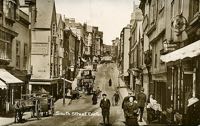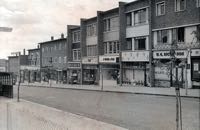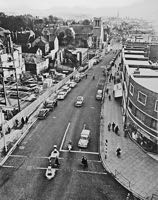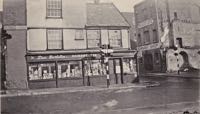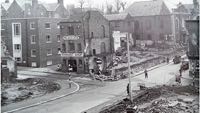
South Street
Page updated 14th April 2017
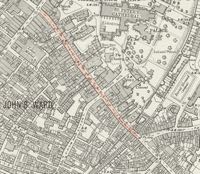 This is the street that led from the Carfax at the
top to the old South Gate, which was demolished in 1819. It was
formerly called South Gate Street. From the Sacred Heart Church at Bear
Street to Kalendar Lane was known as Bell Hill, while at the top was Cook Row or the Shambles,
and was presumably a place to eat. There is a reference on Roques map
to the whole of South Street from Cooks Row down being named
Bolehylle-strete or Bolehill, which probably corrupted to the Bell
Hill, already mentioned. Bolehill may originate from the name of the
hill dropping from the Cathedral down Palace Gate, dating from the 13th
century.
This is the street that led from the Carfax at the
top to the old South Gate, which was demolished in 1819. It was
formerly called South Gate Street. From the Sacred Heart Church at Bear
Street to Kalendar Lane was known as Bell Hill, while at the top was Cook Row or the Shambles,
and was presumably a place to eat. There is a reference on Roques map
to the whole of South Street from Cooks Row down being named
Bolehylle-strete or Bolehill, which probably corrupted to the Bell
Hill, already mentioned. Bolehill may originate from the name of the
hill dropping from the Cathedral down Palace Gate, dating from the 13th
century.
One of Exeter's three wool markets was situated in the Shambles. South Gate Street was the main route into the city from London and the east, and was much narrower than the present thoroughfare.
James Cossins remembered the old Southgate before it was demolished in 1819:
"Being one "of those few living amongst us who have a personal recollection of the outside of the old Bridewell in South street," I am induced to give a few recollections about it. It was called Southgate prison, I have a vivid idea of the sombre appearance of it, standing across the street in a line with the present Trinity Church. Over the archway were the apartments for debtors, from which they had a view up South street, the bulk of the building being by the side adjoining the town wall."
He further wrote about South Street:
"South street was widened in 1830, and was before so narrow that Russell's waggons were sometimes obliged to have goods taken out at the top of the street. The Conduit then extended about eight feet from the College Hall. At a more recent date Bell hill was lowered and widened. An idea may be formed of the former width when I say that the upper parts of some of the houses were just within shaking hands distance... Twenty to thirty people waiting at the conduit in South street for their turn for water the supply at times was so limited that it would take half an hour to fill a bucket or pitcher, and parties had frequently to wait three or four hours for it. Many people may not know why the above was so appreciated : it was considered the best for tea and pea-soup."
The South Street conduit was removed in 1836 to the rear of the Lower Market, in Milk Street, with a stone obelisk to mark the spot - this is approximately in the car park outside the modern FoodEze.
The Exeter Tradesmen's and Mechanics' Institution was founded in 1825, in some rooms at Bell Hill (now South Street). The Institute, which had a membership of 200, had a library of books not deemed to be controversial on theology or politics. One opponent of the Institute, John Cooke wrote ".... take away men from their enjoyment of cakes and ale and you will take away their seven senses". Five years later it evolved into the Literary Society when it moved to the New Inn in the High Street.
Annie Tooke, a child-nurse who lived in South Street, was arrested on the 12 June 1879 for the murder and dismembering of a 6 month old baby named Reginald Hyde. She was hung at Exeter Prison for the crime.
The street was widened in 1830, the first of several modifications from the old, mediaeval width.
The many public houses and businesses in South Street were well represented in the pages of the Exeter Flying Post, along with the odd, but quirky story. One such was in June 1892:
"Swarm of Bees in South-Street – On Sunday was witnessed a novelty in South-street. At about eleven o'clock in the morning a large swarm of bees alighted on the corner of the house of Mr. Norris, auctioneer, and remained in a thick cluster for several hours. A beekeeper, residing in Paris-street, fixed a temporary habitation underneath the swarm in the afternoon and they gradually took up their quarters therein, the whole getting lodged between eight and nine in the evening."
Damage from bombs
South Street was badly damaged in the 1942 blitz, and rebuilt between 1954 and 1961. All the churches survived the blitz, while both the Sacred Heart and Baptist Church survived the Blitz due to the courage of the ministers, caretakers and locals who fire watched on the roof and threw off incendiaries or put out fires.
Although largely rebuilt after the Second World War, some of the buildings at the bottom of South Street date from the mid 15th century, including the White Hart Inn. The shop to the right of the White Hart was the butchers, Reynolds and Sons, then a computer store called Minerva, and now a gallery. It dates back to the early 17th-century and houses two plaster ceilings with pomegranate, lilly and tulip designs. This was the only block of buildings in South Street, apart from the Sacred Heart Church, George's Meeting House (now a Wetherspoon's pub) and the White Ensign Club (Holy Trinity Church) to escape the bombing of May 1942.
Further up South Street, on the corner of Coombe Street, facing Palace Gate, is a modern building of no architectural merit that was constructed for the Commercial Union Insurance Company. It is largely remembered for the time in the early 1960's, when Exeter's first computer was installed by lifting it on a crane and dropping it through a hole in the roof.
Source: Various sources including the Flying Post, Exeter Architecture by Hugh Meller and a Redcoat guide.

George's Meeting House on the right, and the White Hart Hotel in the early 1960s. Photo Dick Passmore.

The home of Commercial Union, Concorde House. Exeter's first computer was installed in this building.
│ Top of Page │
